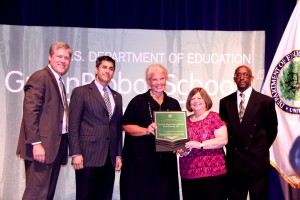
Travilah Elementary School in North Potomac, Md. accepted an award as a U.S. Department of Education Green Ribbon School Tuesday. (Caroline Cataldo/MEDILL)
WASHINGTON — The U.S. Department of Education honored two Maryland public schools Tuesday as Green Ribbon Schools for being leaders in sustainability and science education.
“It’s a mechanism for recognizing high-performing schools and districts – and using their example to spread best practices to other schools and districts,” said Andrea Suarez Falken, director of U.S. Department of Education Green Ribbon Schools.
North Carroll High School in Hampstead in Carroll County and Travilah Elementary School in North Potomac were among 48 schools and nine school districts nationwide that were honored at the awards ceremony in Washington.
The Education Department chose the schools for the award based on three pillars: reducing environmental impact and cost, improving health and wellness, and effective environmental education.
“The idea for this Green Ribbon experience actually came from partners challenging us to figure out what we can do to shine a better spotlight,” said Arne Duncan, U.S. secretary of education. He praised schools for saving millions of dollars while making kids healthier and improving student achievement.
“What’s so amazing is that we’ve done this on basically no budget,” Duncan said. “Given how tough it is to get new money, how tough Congress is – how dysfunctional Congress is – to have such smart people, committed people working and making a difference here, in your communities, across the country – it’s just been amazing to see.”
Falken said recognizing the schools and other Education Department programs, such the Green Strides information page on the agency’s website –should encourage schools to include sustainability in science courses.
At North Carroll, the desire to become more sustainable came from the assistant principal, Gina Felter, and the students, which became the N.C. Green Team. For example, the high school has an American chestnut orchard on its campus tended by students.
“I think when things begin with students then it just grows from there,” said Kimberly Dolch, principal of North Carroll.
The programs at North Carroll also include “Turn off Tuesdays,” a day dedicated to reminding students to turn off the lights, and “Walk for Wellness,” where students are encouraged to take a walk after their lunches.
Dolch said the school has begun composting in the cafeteria using over 5,000 worms to decompose the waste.
North Carroll is trying to upgrade its science, technology, engineering and math classes – also known as STEM – and is also connecting STEM topics to other subjects, such as English and art, Felter said.
Like North Carroll, Travilah Elementary found ways to bring science education to the forefront of classes. Each grade level has its own garden and the children are encouraged through a reward system to jog during recess.
“It becomes part of who they are. If they learn it at an early age to recycle, then they are going to do it throughout their life,” said Susan Shenk, principal at Travilah.
The students also take what they have learned about sustainability home to their communities.
“It’s a community behavior change that our community’s school is bringing to our homes. My child is actually growing his own vegetables and they are telling us how to do the recycling,” said Amjad Riar, whose children attend Travilah.
While the Education Department’s Green Ribbon School initiative is not a grant program and funding for these programs is not directly provided, the agency is hoping to inspire schools to continue making STEM education and environmental sustainability a priority. Informational resources are provided on the education department’s website to help schools get started.
“It’s a communications and outreach tool,” Falken said. “It’s about sharing their practices with all schools and getting the word out about these resources to all schools – more-so than the award itself.”
The Education Department also plans to add a post-secondary school category for the next awards in 2015 to encourage colleges to embrace the practices of the schools, like North Carroll and Travilah.


